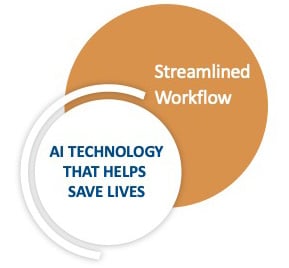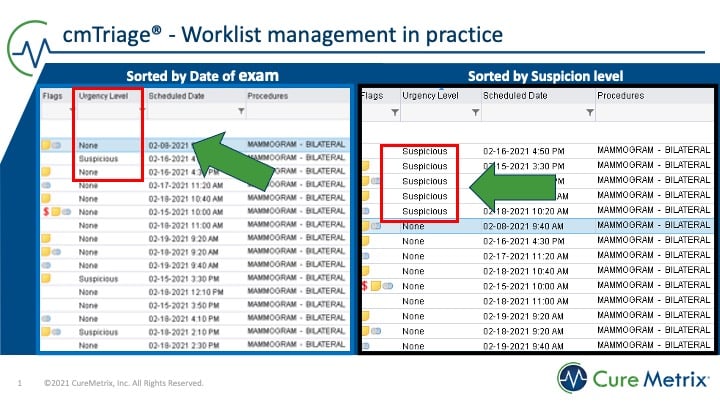Artificial intelligence (AI) for mammography is being adopted more widely by radiologists each day, and much has been said about its benefit for patients. But not as much has been said about how AI improves a practice’s bottom line by streamlining the clinical workflow.
For independent radiology practices, hospital systems and large imaging centers alike, time is money. Practices have a business to run, and any tool that can increase efficiency is necessary for cost savings—and ultimately, the financial health of the practice. AI-based mammography triage tools like CureMetrix cmTriage™ are a groundbreaking way to save time and money – streamlining workflow and building patient trust with better processes and results.

How it Works
cmTriage is the first FDA-cleared AI-based triage platform for mammography. Using a sophisticated algorithm that can detect potential anomalies in a mammogram image, cmTriage sorts suspicious cases to the top of the radiologist’s worklist.
Through triage of suspicious cases on the worklist, the radiologist is able to prioritize those cases, thereby enhancing turnaround time in reporting and faster recall of worrisome exams. Similarly, the exams that are sorted as not suspicious are known to be free of CAD marks and are read with greater ease and efficiency. Dr. Lina Le, a radiologist and the Director of Breast Imaging at Shin Imaging Center in Orange County, CA, can attest:
“cmTriage helps me batch my high priority and low priority cases, allowing me to organize my worklist and spend my time where it’s needed most.”

Research-Proven
A recent study highlights how cmTriage can potentially lead to substantial improvements in both diagnostic performance and workload reduction. Researchers examined 2,129 screening mammograms, without exclusions, from an academic breast center with up to five years of follow-up data, and used cmTriage to retroactively analyze each exam. The study looked at typical audit measures such as recall rate, cancers detected, false negative exams, positive predictive values, sensitivity (number of true-positives/number of cancers), and specificity (number of true-negatives/number of non-cancers). All of these metrics were improved with the use of cmTriage.
Of these 2,129 screening mammograms, cmTriage automatically—and correctly—classified 1,138 of confirmed normal mammograms as low suspicion. In the setting of double reading, this means that 53% of the exams would not have to be double read. In the single reader scenario, internal studies have shown 30-40% faster reading times of low suspicion screening mammograms, without decrease in cancer detection rate or increased recall rate by the radiologists.
An investment in AI tools is worthwhile to maximize radiologists’ productivity and get through the backlogs caused by delayed screenings. Time is money, which means that AI can benefit a practice’s bottom line enormously—but time is also of the essence in cancer diagnosis. As a recent article in Entrepreneur magazine points out, AI saves lives by reducing a radiologist’s workload and increasing their capacity to accurately detect and diagnose breast cancer.
By using AI to enhance efficiency and catch breast cancers earlier, imaging centers and radiology practices also build trust with their patients, leading to more referrals and a healthier business overall.
Request more information and learn more about how cmTriage and other CureMetrix AI solutions can benefit your radiology practice here.


